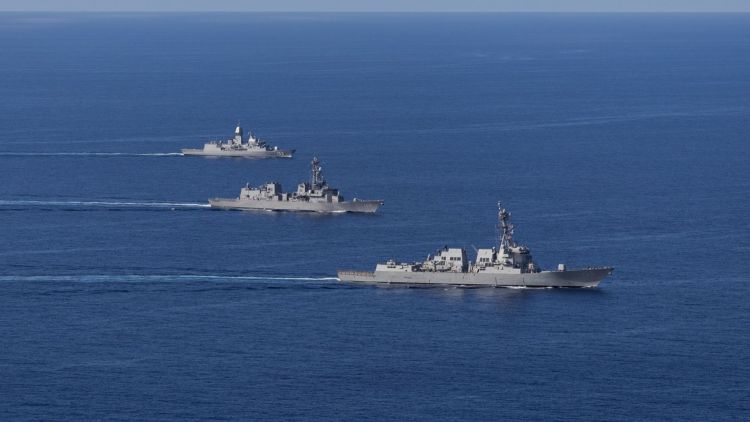If you’ve been keeping an eye on the news, you folks probably have already noticed a significant uptick in military activity in the Indo-Pacific region. From joint naval patrols to high-stakes exercises, the South China Sea and its surrounding waters are turning into a hotbed of strategic maneuvers.
Countries like the Philippines, Japan, Australia, the United States, and even New Zealand are teaming up, while China and Russia flex their naval muscles right back. The big question is: What does all this mean for the future of the region?
Let’s take a quick look at the key moves happening on both sides and how these actions are reshaping power dynamics in the Indo-Pacific.
Multilateral Cooperation in the South China Sea
Recently, the Philippines held a joint patrol in the South China Sea that involved forces from Japan, Australia, the US, and New Zealand. And this looks like more than just a friendly sail around the block.
These exercises reportedly included some serious drills focused on maritime domain awareness, replenishment at sea, and contact reporting—basically, getting everyone on the same page when it comes to naval operations.
Among the participating ships were the BRP Antonio Luna (FF-151) and BRP Emilio Jacinto (PS-35) from the Philippines, USS Howard (DDG-83) from the US, HMAS Sydney (DDG-42) from Australia, JS Sazanami (DD-113) from Japan, and HMNZS Aotearoa (A-11) from New Zealand, among others.
Aside from clearly showing off firepower from the regional partners, this joint naval exercise was the fourth time they have come together to coordinate their naval efforts in the contested waters.
“The activity will be conducted in a manner consistent with international law and with due regard to the safety of navigation and the rights and interests of other States,” the Armed Forces of the Philippines said in a statement cited by the local newspaper Inquirer.Net.
If you’ve been keeping an eye on the news, you folks probably have already noticed a significant uptick in military activity in the Indo-Pacific region. From joint naval patrols to high-stakes exercises, the South China Sea and its surrounding waters are turning into a hotbed of strategic maneuvers.
Countries like the Philippines, Japan, Australia, the United States, and even New Zealand are teaming up, while China and Russia flex their naval muscles right back. The big question is: What does all this mean for the future of the region?
Let’s take a quick look at the key moves happening on both sides and how these actions are reshaping power dynamics in the Indo-Pacific.
Multilateral Cooperation in the South China Sea
Recently, the Philippines held a joint patrol in the South China Sea that involved forces from Japan, Australia, the US, and New Zealand. And this looks like more than just a friendly sail around the block.
These exercises reportedly included some serious drills focused on maritime domain awareness, replenishment at sea, and contact reporting—basically, getting everyone on the same page when it comes to naval operations.
Among the participating ships were the BRP Antonio Luna (FF-151) and BRP Emilio Jacinto (PS-35) from the Philippines, USS Howard (DDG-83) from the US, HMAS Sydney (DDG-42) from Australia, JS Sazanami (DD-113) from Japan, and HMNZS Aotearoa (A-11) from New Zealand, among others.
Aside from clearly showing off firepower from the regional partners, this joint naval exercise was the fourth time they have come together to coordinate their naval efforts in the contested waters.
“The activity will be conducted in a manner consistent with international law and with due regard to the safety of navigation and the rights and interests of other States,” the Armed Forces of the Philippines said in a statement cited by the local newspaper Inquirer.Net.
The presence of Japan in these patrols is particularly significant. For the first time, Japan’s navy publicly sailed through the Taiwan Strait, a narrow body of water separating Taiwan from mainland China.
That’s quite a bold move, especially given the already growing tensions between China and Taiwan.
Japan, alongside Australia and New Zealand, sailed through the tense Taiwan Strait on Wednesday, September 25, before being joined by the Philippines near the vicinity of the Philippine exclusive economic zone off Luzon.
By joining these efforts, Japan is sending a clear message that it’s serious about defending international law and ensuring freedom of navigation in these contested waters.
China’s Bold Naval Movements
While the Philippines and its partners are busy strengthening their alliances, China isn’t sitting idle.
The Chinese Liaoning Carrier Strike Group (CSG), according to a Friday release by Japan’s Joint Staff Office (JSO), is still in the Philippine Sea, where it’s been carrying out numerous fighter and helicopter operations.
Over the course of a week, the Liaoning conducted 250 fighter launches and 160 helicopter operations, a clear show of force in the region.
Japan’s Maritime Self-Defense Force has been closely monitoring China’s activities, tracking the Liaoning with the destroyer JS Asahi (DD-119).
But China’s naval presence in the region isn’t just about keeping their ships in the water. They’re sending a message that they’re here to stay.
At the same time, China’s Shandong CSG has completed its deployment after a round of combat training in the South China Sea and the Western Pacific.
Looks like China is actively preparing its navy for potential combat scenarios, and that alone should get the attention of everyone watching.
Teaming Up: Russia and China’s Growing Military Cooperation
It’s not just China making moves. Russia has also joined the fray, partnering with China for the second phase of their Northern-Joint 2024 exercise.
This is a big deal because it signals growing military cooperation between the two countries, both of which have a vested interest in countering Western influence in the region.
During the joint exercise, ships from both superpowers worked on air defense tasks, anti-submarine warfare, and even simulated attacks from unmanned vehicles.
These naval drills took place in the Sea of Okhotsk, near Russia’s Sakhalin Island, and are designed to show that China and Russia are serious about standing together in the face of any potential threats.
This partnership goes beyond exercises, though.
After the drills, both nations plan to continue joint maritime patrols in the Pacific, expanding their presence and influence in the region.
This raises the stakes for countries like Japan and the US, who have long maintained naval dominance in these vital waters.
Japan’s Increased Vigilance
As China and Russia ramp up their naval presence, Japan is paying close attention.
Over the past week, Japan’s JSO has also reported—apart from China’s movements in the Taiwan Strait and South China Sea—multiple sightings of Russian naval ships moving around Japan’s northern islands, including destroyers, surveillance ships, and corvettes.
Japan has been quick to shadow these vessels with fast-attack craft and maritime patrol aircraft, making sure they know they’re being watched.
This growing naval activity near Japan’s shores has serious implications for Japan’s defense strategy.
Japan, which has traditionally relied on its alliance with the US for security, is now playing a much bigger role in regional defense.
As Beijing and Moscow grow more aggressive, Japan’s involvement in joint patrols and military operations is becoming increasingly critical.
Final Thoughts: What Does This All Mean?
So, what’s the big takeaway from all this naval maneuvering? It’s clear that the Indo-Pacific is becoming the center of a high-stakes geopolitical chess game.
On one side, you have countries like the Philippines, Japan, Australia, and the US working together to ensure freedom of navigation and counter China’s influence.
On the other side, you have China and Russia building a closer military partnership and expanding their presence in the region.
These moves aren’t just about exercises or shows of force—they’re about the future balance of power in the Indo-Pacific.
If these tensions continue to rise, the region could become a flashpoint for conflict, especially as nations compete for control of critical waterways like the South China Sea.
At the end of the day, it’s not just about who has the more oversized navy—it’s about who can form the strongest partnerships and maintain a presence in these contested waters.
The next few years will continue to remain crucial in determining how these power dynamics play out and whether these joint efforts will be enough to keep the peace in the Indo-Pacific.
—
Disclaimer: SOFREP utilizes AI for image generation and article research. Occasionally, it’s like handing a chimpanzee the keys to your liquor cabinet. It’s not always perfect and if a mistake is made, we own up to it full stop. In a world where information comes at us in tidal waves, it is an important tool that helps us sift through the brass for live rounds.



